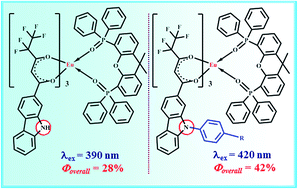Herein, we present the synthesis, characterization and photophysical properties of a series of Eu3+ complexes prepared with novel carbazole-based fluorinated β-diketones, namely, 4,4,5,5,5-pentafluoro-3-hydroxy-1-(9-phenyl-9H-carbazol-2-yl)pent-2-en-1-one (L1) and 4,4,5,5,5-pentafluoro-3-hydroxy-1-(9-(4-methoxyphenyl)-9H-carbazol-2-yl)pent-2-en-1-one (L2) as primary ligands and a bidentate phosphine oxide molecule, 4,5-bis(diphenylphosphino)-9,9-dimethylxanthene oxide (DDXPO) as ancillary ligand. Using the Sparkle/PM3 model the molecular geometries of the designed complexes are optimized and the luminescent parameters are calculated by the LUMPAC software. The results demonstrated that suitably expanded π-conjugation in the developed Eu3+–carbazole based β-diketonate complexes dramatically red-shifted the excitation maximum to the visible region (λex,max = 420 nm) with an impressive quantum yield (34–42%). The triplet state energy levels of L1 and L2 in the complexes are higher than that of the lowest excited level of Eu3+ ion, 5D0, so the photoluminescence mechanism of the Eu3+ complexes was proposed as a ligand-sensitized luminescence process. The predicted luminescent parameters from the Sparkle/PM3 structures are in agreement with the experimental data, which shows the efficacy of the theoretical models adopted in the present study.

